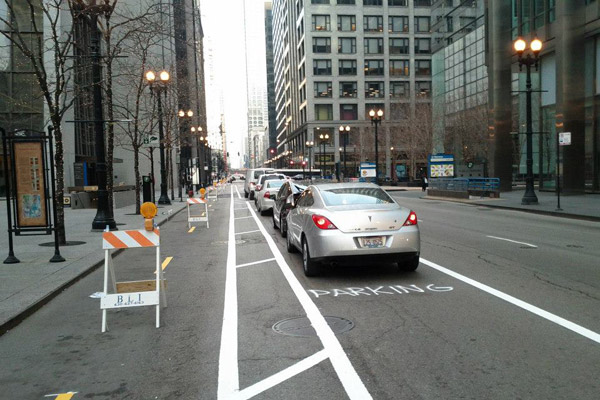
12 blocks of protected bike lane—about a mile—running down a semi-major thoroughfare downtown (Dearborn, between Polk and Kinzie) may seem like a minor thing in the vast stretches of Chicago infrastructure, but we've made Portland, Seattle, and New York jealous:
"That's huge and symbolic," tweeted Portland Mercury News Editor Denis Theriault upon hearing the news, "[Would] Be like putting one here on Washington or Everett."
Yeah. If only.
While excited by what's happening in Chicago (and D.C., and San Francisco, and so on), I can't help but think how great it would be if Portland could muster something this big.
It's "protected" in the sense that cars aren't allowed in it (unlike much of downtown, where "bike lane" just means "bikes are allowed to ride here too, don't hit them please"), not protected in the sense that there's a permanent physical barrier between cars and bikes. But that allows us to do it on the cheap:
Using an estimate from SDOT [Seattle Department of Transportation] that cycle tracks could cost $4-5 million per mile, Council estimated that they could build 0.25 miles of cycle track with the included funding. However, this is by far the highest cost estimate for cycle tracks we have seen compared to other cities (Chicago has built cheapo cycle tracks for $170,000 per mile and Long Beach recently spent about $300,000 per mile, though Vancouver’s downtown cycle track on Hornby cost about 3 million Canadian dollars for a mile). We are following up to learn where such a high estimate came from, and we’re hopeful a less expensive price point could lead to construction of even more of the downtown plan.
Instead, it uses parked cars as a barrier between traffic and bikes. We're also doing it quickly, as John Greenfield notes:
One reason the work is going so fast is that it’s being done by Chicago Department of Transportation (CDOT) crews using paint, rather than contractors using molten thermoplastic, which might be worth considering for all bike lanes. Thermoplastic lasts much longer, but paint is a whole lot cheaper. My friend Dave Schlabowske, former Milwaukee bike coordinator, tells me that city crunched the numbers and found that it was cheaper to repaint their bike lanes every year than to stripe them with thermoplastic once every few years. This also might help with the “disappearing bike lane” problem.
The warm weather has also allowed the lane to go in quickly, as Steven Vance explains.
I also like this point by Greenfield: "One benefit that has already resulted is that, with the removal of one of the three travel lanes, Dearborn already feels calmer and more civilized, like a bustling neighborhood retail street rather than a typical downtown speedway." One of the things I least like about driving downtown is actually how fast it can be when traffic is moving quickly, a pain if you're, say, trying to locate a parking garage; traffic speeds in much of downtown have always surprised me for how frequently high they are, save for the most congested hours.
More importantly, they're safer:
As it turns out, infrastructure really matters. Your chance of injury drops by about 50 percent, relative to that major city street, when riding on a similar road with a bike lane and no parked cars. The same improvement occurs on bike paths and local streets with designated bike routes. And protected bike lanes – with actual barriers separating cyclists from traffic – really make a difference. The risk of injury drops for riders there by 90 percent.
In other good bicycling news, Desplaines/Milwaukee/Kinzie just got a dedicated left-hand-turn lane for bikes, which will keep them out of the motorist turn lane, and the Dearborn bridge will get plates (iron-grid bridges get slick when it rains or snows).
Photograph: Chicago Bicycle Program


